
Many of us lead busy lives that leave little time for reading, and what reading we do happens on our phones. But I’m happy to report that books are still alive and kicking in the outdoors arena.
Here’s a look at some that crossed my desk this year.
FISHING
What angler has not heard that apocryphal lament. “You shoulda been here last week?”
 Ted Rulseh takes that phrase for the title of his new book, a collection of fishing stories four decades in the writing and seven in the living. Rulseh captures moments in time that any angler can relate to.
Ted Rulseh takes that phrase for the title of his new book, a collection of fishing stories four decades in the writing and seven in the living. Rulseh captures moments in time that any angler can relate to.
His early angling outings could have been yours or mine: fishing for suckers and carp on the East Twin River in his hometown of Two Rivers, summer vacations at a rustic cottage on a northern lake, boating memories with his dad and siblings. An evening of smelting helped him get over a teenage crush, and he describes the northwoods mentality that makes some folks abandon city life and eke out a less stressful living above the tension line.
“The Revenge of the Hellgrammites” will resonate with every angler who’s had to explain to a spouse or girlfriend why he keeps his bait in the fridge.
You Shoulda Been Here Last Week: Stories from a Life of Never Quite Enough Fishing, Cornerstone Press, 222 pages, $24.95.
MORE COVERAGE FROM OUTDOOR NEWS:
Looking for holiday gift ideas for the outdoors lover in your life? We’ve got you covered
Top new gear for your 2025-26 ice-angling campaign
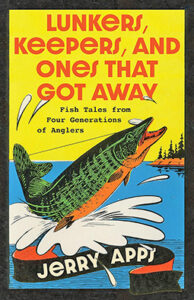 Jerry Apps once asked his 93-year-old father what he would have done differently in his long life. The old man simply replied, “I would have spent more time fishing.”
Jerry Apps once asked his 93-year-old father what he would have done differently in his long life. The old man simply replied, “I would have spent more time fishing.”
Apps must have taken that advice to heart. In Lunkers, Keepers, and Ones That Got Away, Apps regales us with stories gleaned from decades on the water. Now in his 90s himself, Apps has plenty of stories to share, from his earliest outings on Waushara County lakes with his dad and younger twin brothers after panfish with cane poles, to annual trips with his son Steve to the Boundary Waters, and the opening-day “Piscatorial Retreat” to the snow-covered banks of the Peshtigo River with his UW-Madison graduate students.
Apps weaves advice on how and where to fish, what baits work best, and more. This folksy book will appeal to anglers of all ages.
Lunkers, Keepers, and Ones That Got Away: Fish Tales from Four Generations of Anglers, Wisconsin Historical Society Press, 168 pages, $20.
Jerry Audet may not be well known to Upper Midwest readers, but this prolific writer, photographer, and editor is a household name in the saltwater angling world.
 His latest book, Hooked, is a bait bucket list of some of the most sought-after fish from around the world. A casual question from a non-angler at a barbecue, “What makes one fish better than another?” launched Audet on a quest for an answer.
His latest book, Hooked, is a bait bucket list of some of the most sought-after fish from around the world. A casual question from a non-angler at a barbecue, “What makes one fish better than another?” launched Audet on a quest for an answer.
Some anglers told him the fight, or the abundance of a species, or the challenge of catching it makes one species stand out. Others cited the beauty of a fish’s habitat or its accessibility in local waters.
The handful of species Audet addresses all have something in common: “They really matter to the angling community, and we are devoted to them.” He assigns to each fish a level of difficulty to catch, suggests prime locations to try for them, then describes the habitat and offers tips on how to catch one. He concludes with a plea for conservation of fish and their habitats.
Hooked: Legendary Fresh and Saltwater Fish to Catch in a Lifetime, Rock Point, an imprint of Quarto Publishing Group, 224 pages, hardbound, $19.99
HUNTING
A century ago, deer camps were a fixture of the northwoods from Minnesota to Maine.
 Every fall, hunters, almost all of them men, would travel north from southern cities to enjoy a couple of weeks of camaraderie, camp life, and hunting. One such camp is located in a remote section of Northern Wisconsin’s Ashland County, where old-growth pine/hemlock forest was clear cut during the logging era, and second-growth supported a healthy deer herd.
Every fall, hunters, almost all of them men, would travel north from southern cities to enjoy a couple of weeks of camaraderie, camp life, and hunting. One such camp is located in a remote section of Northern Wisconsin’s Ashland County, where old-growth pine/hemlock forest was clear cut during the logging era, and second-growth supported a healthy deer herd.
That prime habitat has matured, and deer numbers have declined, but camp members still venture forth every November to hunt the White River bottoms and surrounding woods. In Red’s Camp, longtime outdoor scribe Steve Heiting chronicles the camp’s 80-year history. The book ends with stories that relate successful hunts, practical jokes, and the building of an ice bridge to move the original camp across the river. Red’s Camp offers us a sampler of the activities at one camp that echo those of camps across the Northwoods.
Red’s Camp: The Story of a Northwoods Deer Hunting Camp, Pinemere Press, 240 pages, $19.95.
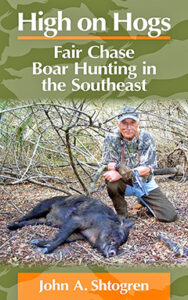 Today, most sportsmen embrace the fair chase ethic for hunting game species, proposed by Teddy Roosevelt and codified by the Boone & Crockett Club. Despite the reputation of wild hogs as a destructive invasive, author John Shtogren argues that because of their wariness, intelligence and difficulty to bring down, wild piggies deserve to be hunted by ethical means, rather than treated as vermin.
Today, most sportsmen embrace the fair chase ethic for hunting game species, proposed by Teddy Roosevelt and codified by the Boone & Crockett Club. Despite the reputation of wild hogs as a destructive invasive, author John Shtogren argues that because of their wariness, intelligence and difficulty to bring down, wild piggies deserve to be hunted by ethical means, rather than treated as vermin.
Shtogren traces the history of wild hogs in the Americas and offers a primer on wild hog biology, behavior and proven hunting tactics. There have been sightings of feral hogs in parts of the Upper Midwest, but their numbers are greatest in the Deep South, Texas and California, the only state that considers them a game animal.
Advice on butchering and cooking wild hogs caps off the book. If you’ve considered hunting them, this book would be a wise investment.
High on Hogs: Fair Chase Boar Hunting in the Southeast, self-published, 140 pages, Get it for $18 autographed and personalized direct from author: jashtogren@yahoo.com.
MEMOIRS
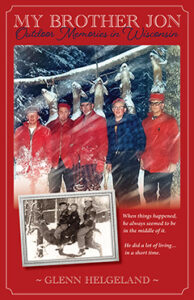 My Brother Jon is more than a loving tribute to a long-departed younger brother.
My Brother Jon is more than a loving tribute to a long-departed younger brother.
Glenn Helgeland’s reminiscences on the daily life of a young family on a small, northern Wisconsin farm in the 1950s and ’60s open a window to a long-gone time in a place that hasn’t changed all that much.
Organized thematically rather than chronologically, the book floats from farm chores like milking cows and threshing oats, to hunting and fishing adventures for deer, pheasants, trout, and muskies. We get to know the three Helgeland brothers and their parents, along with friends, relatives, guides, outfitters, and college roommates.
In a hilarious final chapter, appropriately titled “Crazy Stuff,” Helgeland spins a tall tale about a one-horned Norwegian eland, evokes Darwinian natural selection as he imagines how his ancestors coped with poor eyesight and hearing, and catches bullfrogs with a patch of red flannel on a bare hook. My Brother Jon invites us on a nostalgic voyage into Helgeland’s quirky past.
My Brother Jon: Outdoor Memories in Wisconsin, Target Communications Outdoor Books, 230 pages, $19.95 (paper), $11.95 (e-book).
Missouri-based outdoors writer Kenneith Kieser has caught tarpon in the shadow of Papa Hemingway, hunted waterfowl with the twin to Nash Buckingham’s legendary Fox double “Bo-Whoops,” and humped after a pack of bluetick hounds as they tree raccoons on an oak ridge haunted by Civil War ghosts.
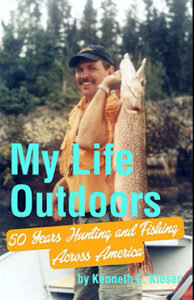 Kieser has stuffed these stories and a couple dozen more into a game pouch of a book he calls My Life Outdoors. Peek into that pouch and you’ll have a glimpse of what a full-time outdoor writer’s life is like.
Kieser has stuffed these stories and a couple dozen more into a game pouch of a book he calls My Life Outdoors. Peek into that pouch and you’ll have a glimpse of what a full-time outdoor writer’s life is like.
Kieser’s straightforward style is reminiscent of Hemingway’s, with just enough description to paint the landscape he traverses and a spare dialog that keeps the stories moving and the reader on the edge of his seat wondering what will happen next.
In “Pass on the Fishing Heritage,” he tells how as a 12-year-old boy, he met Dick Kotis, president of Arbogast Lures at a sports show. Kotis gave him three lures: a Jitterbug, a Hula Popper, and a Hawaiian Wiggler.
A wiser Kieser would have kept those classic lures as treasured mementos, but the young Kieser lost all three in less than 30 minutes to big bass on his family’s farm pond. Nobody tells an outdoor story like Kieser. It’s a wonder he has survived all these adventures.
My Life Outdoors: 50 Years Hunting and Fishing Across America, self-published, 153 pages, $20.
After a decade on the road with the rock band U2, it’s no wonder Dianne Ebertt Beeaff sought solace on the 16-acre southern Ontario parcel where she grew up and now lives.
 Beeaff’s latest book, Infinite Paradise, encourages readers to discover the restorative power of the natural world. This author, poet and artist draws inspiration from Leopold, Thoreau and Wendell Berry, among others, as she focuses a keen eye on a small place, to see, as the poet William Blake wrote, “a world in a grain of sand and a heaven in a wild flower.”
Beeaff’s latest book, Infinite Paradise, encourages readers to discover the restorative power of the natural world. This author, poet and artist draws inspiration from Leopold, Thoreau and Wendell Berry, among others, as she focuses a keen eye on a small place, to see, as the poet William Blake wrote, “a world in a grain of sand and a heaven in a wild flower.”
“I don’t know if it is possible to love the whole planet, but we can love a place we can see and touch and smell,” she writes.
Many outdoors enthusiasts know this intuitively, but it’s a great message to share with those who don’t spend much time off pavement. With a style, organizational format, and attention to detail that evoke Leopold’s A Sand County Almanac, she takes us on seasonal walks through her property, starting in March as the land begins to wake up after a long winter.
In some entries, Beeaff begins with a close look at something growing or living on her 16 acres, then expands her view to how the Native people who lived there used it for its nutritional, medical, or spiritual properties.
Throughout the book, Beeaff weaves musings as disparate as the impact of conservation milestones like the Clean Water Act, the origin of the popular tequila drink margarita and the annual growth of deer and elk antlers. A soothing read for busy minds.
Infinite Paradise: Witnessing the Wild, She Writes Press, 312 pages, $17.99
ODDS & ENDS
Who doesn’t love a good chainsaw? James Card, for one, surely does.
 “There’s an enormous amount of peacefulness and solitude while a two-stroke engine is roaring in your hands,” he writes in Chainsaw Love.
“There’s an enormous amount of peacefulness and solitude while a two-stroke engine is roaring in your hands,” he writes in Chainsaw Love.
The central Wisconsin author’s affection for chainsaws began when, as a young boy, he tagged along with his dad on a visit to Woods Sales & Service in Black River Falls: “Browsing this family-owned store with the new chainsaws on the shelves set me off on a lifelong fascination with a machine that later became an essential and cherished tool in my everyday world as an adult.”
Part homage, part social history, and part field guide, Chainsaw Love runs the gamut from firewood to lumberjack competitions, from cleaning up a zombie ash stand to cutting a hole for spearing sturgeon. To a psychotic maniac, the saw is a lethal weapon; to a woodcarver, it’s an artist’s chisel.
For Card, running a saw is therapeutic, it “has a magical power to solve any problem I might face. […]” He worked a stint as a line-clearance tree trimmer and still puts up firewood for his woodburner every year. Card considers the saw’s place in pop culture, and he shares insights into saw styles and parts, maintenance guidelines, and safety.
Chainsaw Love: Field Notes on the World’s Most Dynamic Power Tool, Wisconsin Historical Society Press, 240 pages, $27.95 (paper), $19.99 (e-book).
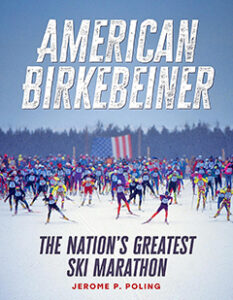 When Tony Wise launched the first American Birkebeiner ski race in 1973, 54 hardy souls kicked and glided from the Lumberjack Bowl in Hayward, Wis., to Wise’s Mt. Telemark Chalet outside of Cable. Fast-forward to the Birkie’s 50th anniversary in 2024, when 12,700 tights-clad athletes skied the 50k freestyle or 30k classic race. Wise was onto something.
When Tony Wise launched the first American Birkebeiner ski race in 1973, 54 hardy souls kicked and glided from the Lumberjack Bowl in Hayward, Wis., to Wise’s Mt. Telemark Chalet outside of Cable. Fast-forward to the Birkie’s 50th anniversary in 2024, when 12,700 tights-clad athletes skied the 50k freestyle or 30k classic race. Wise was onto something.
Wise had already built a thriving summer playland at the Lumberjack Bowl in Hayward and an alpine ski resort at Mt. Telemark, so his venture into cross-country was not that crazy a leap. Eau Claire author Jerome Poling knows the Birkie intimately, having reported on it for more than 40 years and skied it himself 25 times since 1982. In American Birkebeiner, Poling offers a short but fascinating biography of the visionary Wise, then traces the history of the race and its associated events.
American Birkebeiner: The Nation’s Greatest Ski Marathon, Wisconsin Historical Society Press, 344 pages, hardbound, $45.
 Today, the lake sturgeon is a familiar fish to Wisconsinites. A century ago, unregulated harvest nearly drove sturgeon to extinction, but strict regulations and a concerted restoration effort brought them back.
Today, the lake sturgeon is a familiar fish to Wisconsinites. A century ago, unregulated harvest nearly drove sturgeon to extinction, but strict regulations and a concerted restoration effort brought them back.
Now, in September, we soak a gob of nightcrawlers on sturdy saltwater rigs in the Chippewa, Flambeau, or Wisconsin rivers in hopes of catching one longer than the 60-inch size limit. In February, we sit on frozen Lake Winnebago. And in April, we get up close and personal with them on their spawning ritual along shoreline riprap on the Wolf River from New London to Shawano.
In Saving Our Sturgeon, noted children’s book author Rebecca Hogue Wojahn explores the natural history of the lake sturgeon and the factors that threatened its survival, from overharvesting to the building of dams that prevented sturgeon from reaching spawning areas.
The book’s maps, photos, diagrams, and timeline of events provide a great resource.
Saving Our Sturgeon: Protecting Wisconsin’s Ancient Fish, Wisconsin Historical Society Press, 136 pages, $20 (paper), $15.99 (e-book).
 Prolific fly-fishing writer Chris Santella left us far too soon last May at the age of 61. Best known for the Fifty Places series that began with Fifty Places to Fly Fish Before You Die, Santella’s last work is a novella that will ring true for anyone who has ever worked at or visited a remote fishing lodge.
Prolific fly-fishing writer Chris Santella left us far too soon last May at the age of 61. Best known for the Fifty Places series that began with Fifty Places to Fly Fish Before You Die, Santella’s last work is a novella that will ring true for anyone who has ever worked at or visited a remote fishing lodge.
Belgian Flats, published shortly after Santella’s death, is the story of Cody, a 30-ish fly-fishing guide who leaves his comfortable job with a Wyoming outfitter to take on the role of camp host at a prestigious fly-in Atlantic salmon resort in northwestern Russia.
The true-to-life characters include Russian oligarchs, reindeer herdsmen, a comical assortment of well-heeled British anglers, a camp manager who stays in shape by doing parkour backflips off rooftops, a green-eyed Finnish environmental consultant named Elyse, and Cody’s mentor, J.D. Smithers, who keeps popping up wearing a jacket that always seems to have a couple of cans of Sierra Nevada Pale Ale in an inside pocket.
Belgian Flats, Lyons Press, 168 pages, paper, $24.95.
I hope you can find a title or two here that will make good fireside reading this winter or a holiday gift.
Outdoor News may earn revenue from products shown on this page by participating in affiliate programs. This comes at no extra cost to you. Click here to learn more.
Original Source: https://www.outdoornews.com/2025/11/23/must-have-reads-for-the-outdoors-enthusiast-heres-dan-smalls-2025-book-review/


Leave a Reply